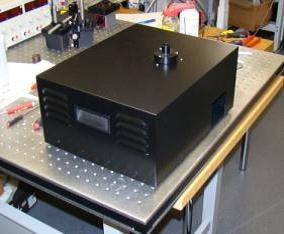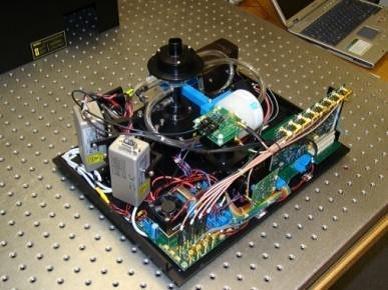Detecting airborne bio-organisms
Submitting Institution
University of HertfordshireUnit of Assessment
PhysicsSummary Impact Type
TechnologicalResearch Subject Area(s)
Physical Sciences: Atomic, Molecular, Nuclear, Particle and Plasma Physics, Other Physical Sciences
Technology: Communications Technologies
Summary of the impact
Since the 1990s, the threat from malevolent release of airborne pathogens
has grown in military and civilian contexts. However, solid-state UV
lasers, central to the preferred fluorescence detection technologies, were
prohibitively expensive for use in `low-cost' detectors. In 2001,
Hertfordshire researchers proposed an alternative based on inexpensive
xenon flashlamp sources, commonly used in disposable cameras. Between 2001
and 2006, they developed and optimised this approach, with the resulting
`WIBS' technology now a core part of the UK military's bioaerosol defence
programme and patented worldwide. The technology's affordability also has
led to its growing international use in areas such as atmospheric science,
climate research, and occupational health. In 2012, a commercial licence
was purchased by a leading US instrumentation company to exploit in the
field of atmospheric and climate science; discussions with further
licensees to exploit in other fields are continuing.
Underpinning research
After the attacks on the World Trade Center and the Pentagon on 11
September 2001, the perceived threat of terrorist bioaerosol attack on
civilian targets increased significantly. In countering this risk, it was
seen as imperative to have bioaerosol detection systems capable of
providing a real-time warning of attack in sensitive or vulnerable areas
such as underground rail networks, shopping malls and airports.
Existing real-time military bioaerosol detection technology, developed
primarily for battlefields, was prohibitively expensive for widespread
deployment in urban civilian situations. Such technologies were
predominantly based on exploiting intrinsic particle fluorescence to
provide real-time discrimination between biological and non-biological
airborne particles in the ambient environment. A major part of the cost of
these systems came from the expensive solid-state UV lasers (typically
£10,000-£25,000 each) that were required to excite specific fluorophores,
such as tryptophan, present only within biological particles. Indeed,
since potential biological agent discrimination could be enhanced by using
more than one UV excitation wavelength, frequently two or more such lasers
were deployed.
In 2001, [text removed for publication] the US government launched its
[text removed for publication], five-year Semiconductor UltraViolet
Optical Sources (SUVOS) research programme, to seek the development of UV
diode lasers or LEDs of sufficient power to be used for bioaerosol
fluorescence detection. By its conclusion in 2006, SUVOS had resulted in
the realisation of both diode lasers and LEDs down to the sub-300nm
wavelengths required for tryptophan excitation; however, laser lifetimes
and output energy densities remained too low to excite detectable
fluorescence from targets as small as individual bacterial spores.
In parallel with the US SUVOS initiative, Professor Paul Kaye and
colleagues Edwin Hirst and Warren Stanley in the university's Centre for
Atmospheric and Instrumentation Research (CAIR) proposed in 2001 a radical
alternative approach to the low-cost fluorescence excitation of single
airborne biological particles - one based on the multi-UV-wavelength
excitation from compact xenon flashlamps, relatives of those found in
disposable camera `flash' units.
Professor Kaye's investigations were funded by Dstl (Defence Science
& Technology Laboratory) via a series of awards from 2001 to 2007. The
research focused on overcoming the numerous technical challenges of using
xenon flashlamps. These included: substantial improvement in the
`blocking' of radiation from the flashlamps outside the desired UV
wavelength bands; design of compact high-efficiency optical systems both
to deliver the UV radiation to the particle and capture the resulting
fluorescence (this involved the use of custom-designed mirrors and
coatings); aerodynamic modelling of aerosol delivery systems to ensure
particles carried in the sample airflow were exposed individually to the
UV radiation; and optically quenching unwanted fluorescence from other
components within the instrument that threatened to dominate the
ultra-weak fluorescence from the particles. One by one, these challenges
were overcome, and the effectiveness of using xenon sources to achieve
real-time discrimination of airborne biological particles was demonstrated
in major field trials in both the UK and the US. These findings were
disseminated via presentation at major international defence conferences
and publication in refereed journals, and formed the basis of
international patents (see Section 3).
The resulting technology developed at the university was initially named
the Wide Issue Bioaerosol Sensor (WIBS) (modified to `Waveband Integrated
Bioaerosol Sensor' in civilian application fields) to reflect its
potential for deployment in networks of sensors throughout areas
vulnerable to bio-terrorism. [text removed for publication]
References to the research
- The top three publications are indicated by **
1. A low-cost multi-channel aerosol fluorescence sensor for networked
deployment. Kaye P.H., Hirst E., Foot V.E., Clark J.M., and Baxter K., Proc.
SPIE European Symposium Optics/Photonics in Security and Defence,
388-398, London, Oct. 2004. doi: 10.1117/12.578283 (PDF available on
request.)
2. A dual-wavelength single particle aerosol fluorescence monitor. Kaye
P.H., Stanley W.R., Foot V E., Baxter K., and Barrington S.J., Proc.
SPIE Conference on Optically Based Biological and Chemical Sensing for
Defence II, Bruges Sept. 2005. Eds Carrano J C. and Zukauskas A.,
vol. 5990, 59900N-1 to 59900N-12, 2005. doi: 10.1117/12.629868 (PDF
available on request.)
3. A single-particle multichannel bio-aerosol fluorescence sensor. Kaye
P.H., Stanley W.R., Hirst E., Foot E.V., Baxter K.L. and Barrington S.J. Optics
Express 13, 10, 3583-3593, 2005. doi: 10.1364/OPEX.13.003583 **
4. Measurements and comparison of primary biological aerosol above and
below a tropical forest canopy using a dual channel fluorescence
spectrometer. Gabey A.M., Gallagher M.W., Whitehead J., Dorsey J.R., Kaye
P.H. and Stanley W.R., Atmospheric Chemistry and Physics, 10,
4453-4466, 2010. doi: 10.5194/acp-10-4453-2010 **
- REF2 Output
5. Cluster analysis of WIBS single-particle bioaerosol data. Robinson
N.H., Allan J.D., Huffman J.A., Kaye P.H., Foot V.E. and Gallagher M. Atmospheric
Measurement Techniques, 6, 337-347, 2013.
doi:10.5194/amt-6-337-2013 **
- REF2 Output
Patents
Patent examples (both documents available on request):
1. US7436515, Fluid borne particle analysers, inventors Kaye P.H. and
Hirst E.
2. US20100328665, Fluid-borne particle detector, inventors Kaye P.H. and
Stanley W.R.
Key Research Awards
| Dstl |
RD031-929596 |
[text removed for publication] |
Low-cost Fluorescence Detector |
2001–4 |
| Dstl |
RD031-09362 |
[text removed for publication] |
WIBS2 (Wide Issue Bioaerosol Sensor) |
2004–5 |
| Dstl |
RD031-012620 |
[text removed for publication] |
WIBS2s Bioaerosol Smart Sensor |
2005–6 |
| Dstl |
RD031-014543 |
[text removed for publication] |
WIBS3 Technology Advancement |
2006–7 |
| Dstl and US Army |
TP10 programme |
[text removed for publication] |
Joint US/UK biosensor development |
2007–9 |
| [text removed for publication] |
|
|
|
|
Details of the impact
Since 2008, the WIBS technology developed by the university has been
widely adopted by diverse organisations in the UK and overseas. Developed
primarily as a device to help protect against bio-terrorism, the generic
bioaerosol detection capabilities of the technology have proven to be
equally successful for detecting and classifying other, non-pathogenic,
airborne biological particles such as pollen grains and fungal spores. It
has therefore been used extensively by members of the atmospheric science
and environmental monitoring communities to aid research into the
behaviour of natural bioaerosols that play such a prominent role in areas
such as public health (allergens, Farmer's Lung, etc) and the impact of
bioaerosols in areas of cloud microphysical processes, precipitation and,
ultimately, climate change (see, for example, Section 5, Reference 4).
This has led to a far broader exploitation base for the WIBS technology
than originally envisaged.

 A UH-designed WIBS4 instrument
A UH-designed WIBS4 instrument
4.1 2008 onwards: Biological Organism Detection
WIBS core technology incorporating the use of xenon flashlamps to excite
potential bio-fluorophores in sampled environmental aerosol was licensed
by Biral Ltd, Portishead, Bristol, for use in their Verotect military
bioaerosol sensor and AFS Standalone Fluorescence Sensor, the latter for
use in areas such as disease transmission research, environmental
monitoring, etc. These instruments continue to be marketed worldwide.
4.2 2008-10: Government Strategic Planning — Defence
[text removed for publication]
4.3 2008 onwards: Atmospheric Science and Environmental Monitoring
Public dissemination of the capabilities of WIBS technology (including
those in Section 3) quickly led to interest from other fields in which the
ability to detect and classify airborne biological particles in real time
was urgently required. These included:
- Atmospheric science, where WIBS for the first time allowed measurement
of time-varying bioaerosol fluxes into the atmosphere. These naturally
occurring bioaerosol `plumes' play a vital role in cloud formation and
subsequent precipitation patterns, radiative cooling of the atmosphere;
- Industrial hygiene, where monitoring bioaerosols in, for example, food
production facilities, clean-rooms, and hospital theatres is a priority;
- Indoor and outdoor environmental monitoring of airborne allergens,
such as pollens and fungal spores, and airborne pathogens.
See Section 5 for representative end-user publications.
As part of this wider deployment of WIBS technology, specific variants
were commissioned from the university by governmental and other research
organisations in the UK, Eire, Germany, the US and Japan.
4.4 2009-11: Application in Vulnerable Civilian Contexts
[text removed for publication]
4.5 2012: Intellectual Property and Commercial Exploitation
The international patents and patent applications covering the WIBS
technology name University of Hertfordshire researchers Paul Kaye, Warren
Stanley, and Edwin Hirst as inventors. Since the underpinning research for
WIBS was funded by Dstl, the patents were automatically assigned to the
Secretary of State for Defence, with royalties payable to the University
of Hertfordshire upon commercial exploitation. A licence to commercially
produce WIBS instruments has since been granted by Ploughshare Innovations
Ltd (Dstl's intellectual property exploitation arm), to Droplet
Measurement Technologies (DMT) Inc., Boulder, Colorado, a world-leading
manufacturer of atmospheric measurement instruments. Ploughshare are
continuing discussions with commercial organisations regarding licences in
fields other than atmospheric science.
Sources to corroborate the impact
Example WIBS End-User Publications (no University
of Hertfordshire authorship)
- Aerosol fluxes and dynamics within and above a tropical rainforest in
South-East Asia (2010). J.D. Whitehead, M.W. Gallagher, J.R. Dorsey et
al. Atmospheric Chemistry and Physics, 10, 19, 9369-9382. doi:
10.5194/acp-10-9369-2010
- Measurement of the particle counting efficiency of the `Waveband
Integrated Bioaerosol Sensor' model number 4 (WIBS-4) (2012). David A.
Healy, David O'Connor and John R. Sodeau. Journal of Aerosol Science,
47, 94-99. doi: 10.1016/j.jaerosci.2012.01.003
- The online detection of biological particle emissions from selected
agricultural materials using the WIBS-4 (Waveband Integrated Bioaerosol
Sensor) technique (2013). D.J. O'Connor, D.A. Healy, and J.R. Sodeau, Atmospheric
Environment, 80, 415-435. doi: 10.1016/j.atmosenv.2013.07.051.
- Fluorescent biological aerosol particles measured with the Waveband
Integrated Bioaerosol Sensor WIBS-4: laboratory tests combined with a
one year fb01eld study (2013). E. Toprak and M. Schnaiter, Atmospheric
Chemistry and Physics, 13, 225-243. doi:10.5194/acp-13-225-2013
End-User Corroboration
Contact details for individuals and organisations who can corroborate the
impact described in paragraphs 4.1 to 4.5 have been supplied separately.